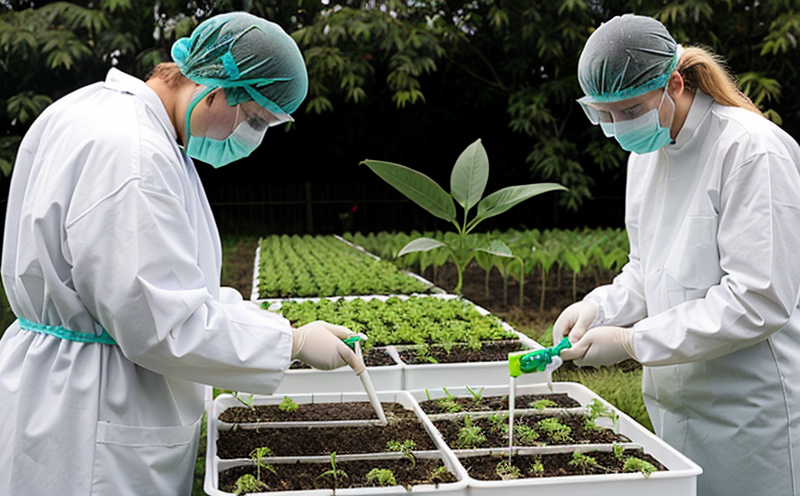Water-Borne Plant Pathogen Testing
In agriculture and forestry, water plays a critical role in plant health and productivity. Water-borne pathogens can significantly impact crops by causing diseases that reduce yield and quality. Accurate identification and quantification of these pathogens are essential for implementing effective control measures. This service focuses on detecting and identifying water-borne plant pathogens using state-of-the-art techniques.
Water-borne pathogens can enter agricultural systems through irrigation, rainwater run-off, or contaminated soil. Common pathogens include Botrytis cinerea, Fusarium oxysporum, and Pseudomonas syringae. These pathogens not only affect plants but also the entire ecosystem, leading to economic losses for farmers and environmental degradation.
The testing process begins with collecting water samples from various sources such as irrigation systems, ponds, and rivers. The sample collection must follow strict protocols to ensure that no contamination occurs during sampling. Once collected, the samples are processed in our laboratory using advanced technologies like qPCR (quantitative polymerase chain reaction) and ELISA (enzyme-linked immunosorbent assay).
qPCR is particularly useful for detecting low levels of pathogens and quantifying them accurately. This technique allows us to determine the concentration of specific pathogens present in a given volume of water, which helps in assessing potential risks to crops. Additionally, ELISA provides rapid results by measuring the presence or absence of antibodies against certain pathogens.
Our laboratory adheres to international standards such as ISO 17025 for quality assurance and reliability. We follow strict protocols recommended by organizations like the American Society for Testing and Materials (ASTM) and the International Organization for Standardization (ISO). These guidelines ensure that our testing methods are consistent, accurate, and reproducible.
For comprehensive analysis, we also employ advanced imaging techniques such as electron microscopy and confocal laser scanning microscopy. These tools provide high-resolution images of pathogens, aiding in their identification and classification. This information is crucial for developing targeted control strategies to mitigate the spread of water-borne diseases.
The results from our testing are detailed reports that include pathogen identification, concentration levels, and potential risk assessments. These reports help stakeholders make informed decisions regarding irrigation practices and other agricultural activities. By understanding the presence and prevalence of water-borne pathogens, farmers can adopt preventive measures such as alternative irrigation sources or disinfection processes.
We pride ourselves on providing reliable and accurate results within a reasonable timeframe to support your decision-making process. Our team of experts ensures that every step of the testing procedure is conducted meticulously, ensuring high-quality outputs. This service plays a vital role in safeguarding plant health and maintaining sustainable agricultural practices.
Applied Standards
This service adheres to several international standards that ensure accuracy, reliability, and consistency of our testing methods:
- ISO 17025: Laboratory accreditation standard ensuring quality assurance.
- ASTM E641-18: Standard practice for the preparation of water samples intended for microbiological examination.
- ISO 3946:2019: Specifications and methods for determining coliform bacteria in water by multiple-tube fermentation technique.
The use of these standards guarantees that our testing methodologies are aligned with global best practices, providing you with confidence in the results we deliver.
Scope and Methodology
The scope of this service includes comprehensive identification and quantification of water-borne plant pathogens. Our methodology involves several key steps:
- Sample Collection: We collect water samples from various sources such as irrigation systems, ponds, and rivers.
- Preparation: The collected samples undergo thorough preparation before analysis using techniques like filtration and dilution.
- Detection: Advanced technologies such as qPCR and ELISA are used to detect the presence of specific pathogens.
- Imaging: High-resolution imaging techniques provide detailed insights into pathogen morphology for accurate identification.
- Reporting: Detailed reports summarizing test results, including concentrations and risk assessments, are provided.
The entire process is conducted in accordance with international standards to ensure high accuracy and reliability. Our team of experts ensures that each step is meticulously followed, delivering precise and actionable insights.
Environmental and Sustainability Contributions
- Reduction in Pathogen Spread: By identifying and quantifying water-borne pathogens early, we help prevent their spread to crops, reducing potential damage.
- Avoidance of Overuse of Chemicals: Accurate testing allows for targeted interventions, minimizing the use of chemical treatments that can harm the environment.
- Supporting Sustainable Practices: Our service promotes sustainable agricultural practices by providing data-driven recommendations to protect plant health without compromising environmental integrity.
Through our efforts, we contribute to a healthier ecosystem and support long-term sustainability in agriculture and forestry.





